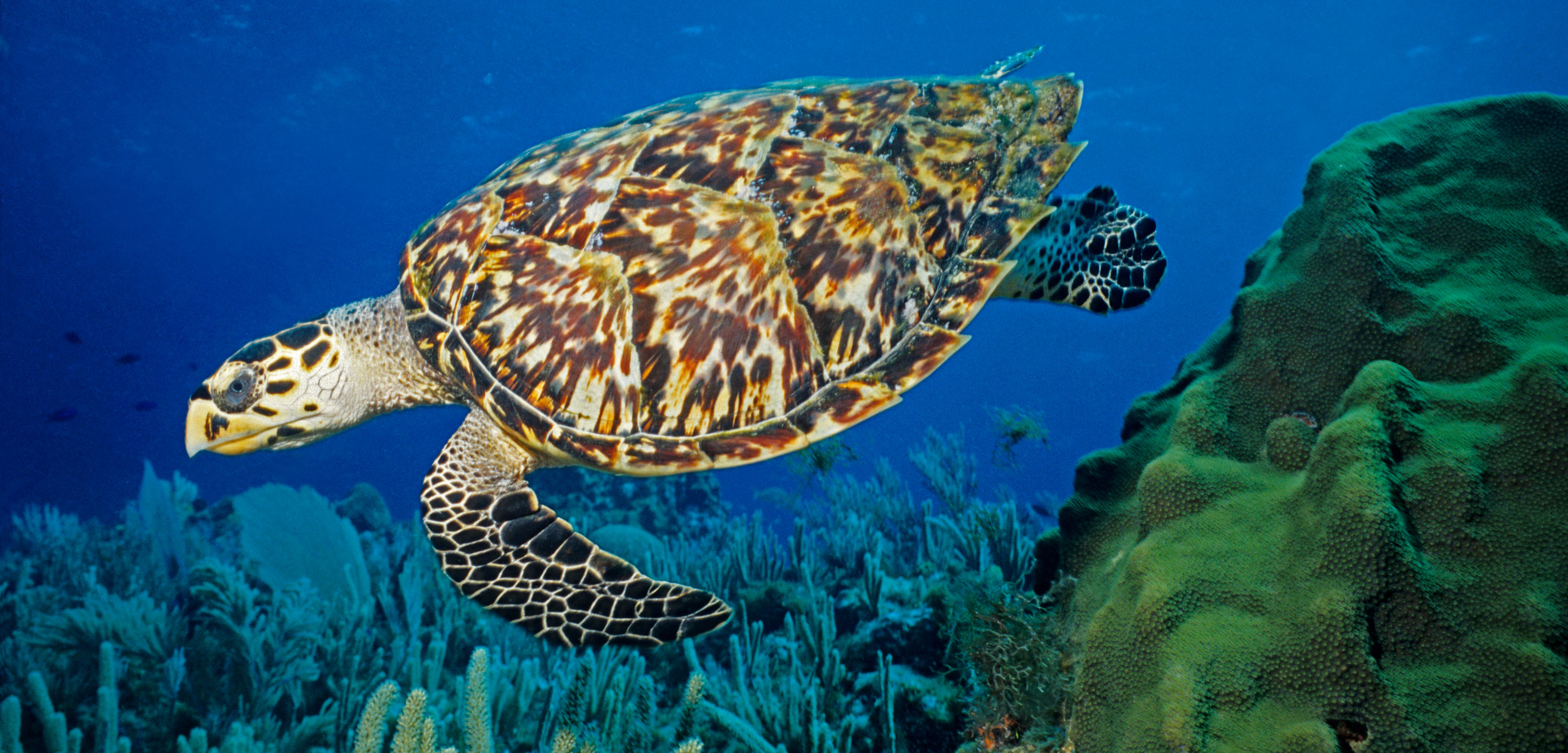Hawksbill Turtles Paid a High Price for Beauty
The tortoiseshell trade was a complex system that spanned the globe, and it was worse for hawksbills than previously thought.
Article body copy
Prettiness has its downsides. For hawksbill turtles, their beautifully patterned yellow and brown shells—called tortoiseshell—have almost been their undoing. Carved into combs, jewelry, and sunglass frames, or inlaid into desks and boxes, tortoiseshell has been heavily traded for decades, depleting the population of hawksbills. A comprehensive new study has found that the massacre is far worse than earlier estimates, which has implications for recovery goals of this critically endangered species.
Covering 1844 to 1992, the new study surveyed 108 more years of data than previous studies. The results indicate that people have harvested six times more hawksbills for the tortoiseshell trade than originally presumed.
“Even this conservative estimate is much higher than previously reported numbers, and significant when considering the global population size of hawksbill turtles now,” says Emily Miller, lead author on the new study and researcher at the Monterey Bay Aquarium in California.
The researchers gathered and analyzed two types of historical records: the legal trade in tortoiseshells reported in customs forms and other logs, and seizure records of illegally traded hawksbills. The numbers revealed that an estimated nine million hawksbills lost their lives in the name of beauty, far more than the original estimate of 1.5 million. The final tally, however, could easily be several million higher when considering additional unrecorded trade and illegal shipments that slipped through border checks, as well as turtles sold whole for decor and curios, notes Kyle Van Houtan, coauthor and chief scientist for the Monterey Bay Aquarium. Today the global population of nesting females is around 25,000—at least 10 times fewer females than in the 1800s, scientists estimate.
Some researchers believe hawksbills were a naturally small population of sea turtles, even before they became internationally coveted. But that’s likely not the case. “What [the study] shows is that the historical exploitation was massive and that these historical populations were not small,” Van Houtan says.
The scientists spent a decade collecting and translating historical trade records of scutes—the bony plates of a turtle shell. Japan, which historically has had the largest import market, had the most detailed records but there was also data from the Solomon Islands, Australia, Caribbean nations, Central America, and several other countries.
The historical logs all recorded the mass of the shells, not the number of turtles. To translate mass into the number of individuals, the scientists weighed and measured scutes seized from traffickers to determine the number per kilogram. Then, using their understanding of the number and size of scutes on juvenile and adult hawksbills, they estimated how many individuals had been harvested.
In addition to the trade records, the scientists collected information on illegally traded scutes seized since 1977, after a ban drafted by the Convention on International Trade in Endangered Species went into effect.
The study also uncovered the evolution of the hawksbill trade, which became increasingly complex after 1950.
Before the turn of the 20th century, India had been the largest exporter. But by mid-century, over 50 countries supplied tortoiseshell, primarily to Japan and Hong Kong. Indonesia was the largest exporter during this period and their exports peaked in the late 1970s as traders rushed to sell off stockpiles as the country prepared to enforce the ban in 1979. Today, illegal trade continues. Between 1999 and 2018, the United States seized illegal shipments of hawksbills coming into the country from over 70 countries.
While the tortoiseshell industry is much diminished, by revealing the intricate trade routes and clandestine nature of the activity, the research can help stop illegal trade, says Jeffrey Seminoff, a marine ecologist at the National Oceanic and Atmospheric Administration’s Southwest Fisheries Science Center in California, who was not involved in the new study. “A paper like this can start to give us some ideas of where we need to look to try and find and break apart those trade routes.”
Additionally, the new study will help conservationists understand what the baseline population levels may have looked like, giving them recovery goals. Already some conservation programs, such as the Eastern Pacific Hawksbill Initiative, are working to raise turtle numbers. The organization hires former poachers to collect eggs, which are protected in nurseries until they hatch. The program has released more than 345,000 hatchling hawksbills into the wild on beaches from Mexico to Ecuador since 2008.
“You basically turn those poachers into team members. And it has worked incredibly well,” Seminoff says.
Many conservationists agree sea turtle conservation requires grass roots movements within local communities, as well as domestic and international laws and regulations. Ultimately, conserving hawksbills may help more than the turtles and their habitat: the study also revealed that areas where the tortoiseshell trade thrived historically tend to harbor other illicit activities today.
Curbing the illegal trade of one will likely help curtail illegal fishing, human trafficking, and other crimes, Miller says.

